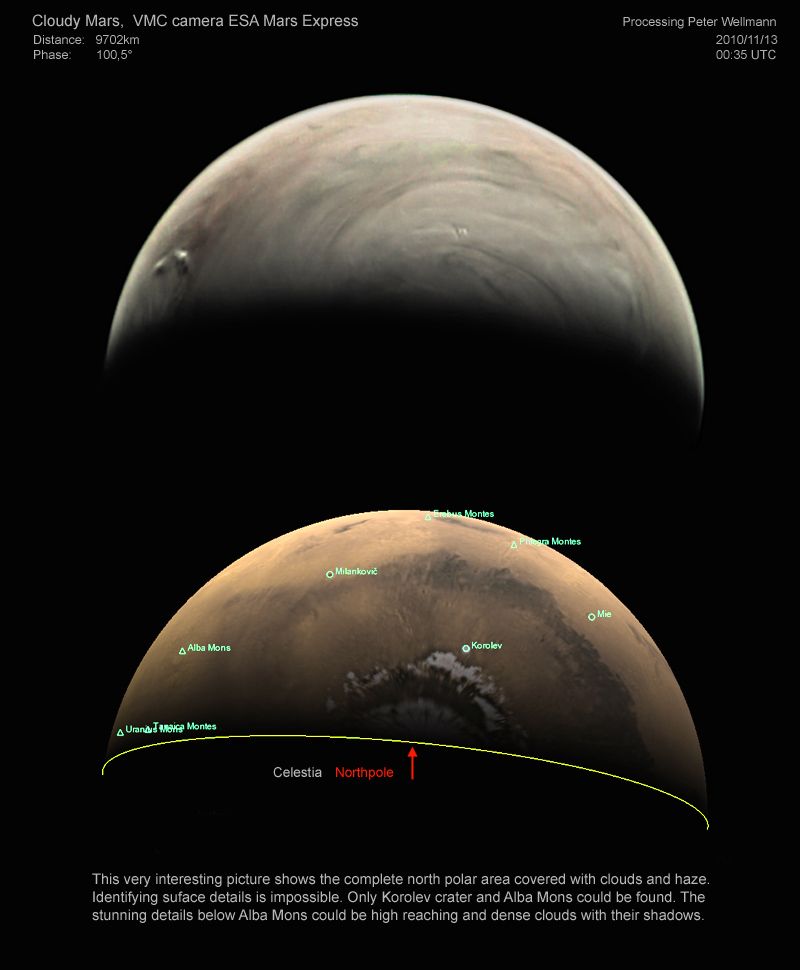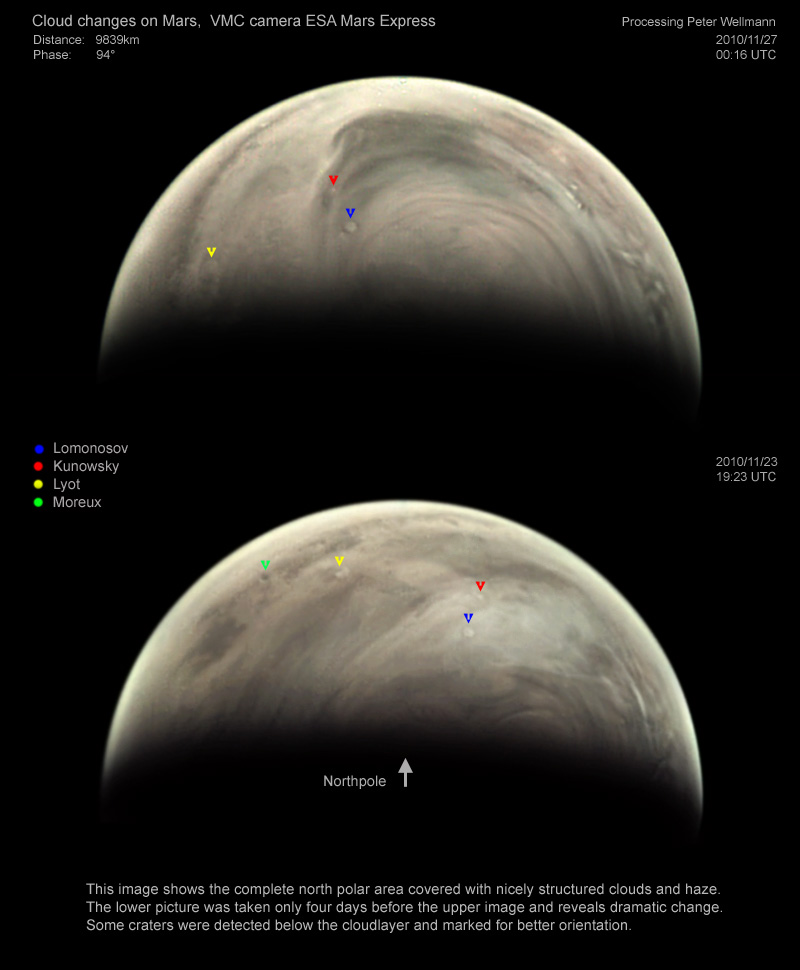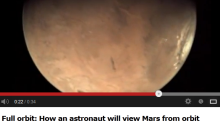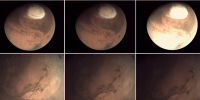We would like to make a correction on our last blog update from Wednesday; Peter Wellmann had in fact submitted three versions of Mars’ North Polar Regions. The corrected versions are all below. To read more about how Peter did his processing, check out the footnotes at the bottom of the page (after the jump..). Enjoy! And thanks, Peter for these impressive results. — Daniel
 The first picture shows almost all of the North Pole, surrounded in a dense cloudy haze. Craters Korolev and Alba Mons have been located easily.
The first picture shows almost all of the North Pole, surrounded in a dense cloudy haze. Craters Korolev and Alba Mons have been located easily.
Peter wrote: “This very interesting VMC-material shows the almost complete North Polar Region and its surrounding area covered with clouds and haze. Identifying the surface details is impossible. Only Korolev crater and Alba Mons could be found. The stunning details below Alba Mons could be high reaching and dense clouds with their shadows. These gigantic clouds extend roughly over 150km. Sometimes sand storms cover the whole planet with dust, but never before have I seen Mars with such a large cloudy and hazy area. The surface structure is clearly visible only in small areas around Alba Mons, even the North Polar Cap is not detected safely, even though the pole is situated right on the terminator. The clouds show an interesting spiral structure, probably induced by coriolis force acting on air streaming out of a high pressure area on the northern hemisphere of a left spinning planet. Although there is little sharp detail in the raw-material I decided to give it a try.”
The second edit shows a similar situation as the first picture, the only difference being that they are on different sides of the hemisphere. This picture shows the complete polar region and the craters Acidalia Planitia, Lyot and Lomonosov could be clearly detected. The entire pole is covered with nicely structured clouds and haze.
Peter wrote: “This very interesting VMC-picture should be seen as supplement to my previous submitted image 2010/11/13. It shows the part of the polar region not visible on the 2010/11/13 image. Almost the entire North Pole and surrounding area is covered with nicely structured clouds and haze. Identifying surface details is not easily accomplished. Only Acidalia Planitia is partly free of clouds, and Lomonosov crater can be easily detected. On a second look the large crater Lyot is seen full size inside a semicircle of clouds. Some other structures are easily detected by comparing with the Celestia image, but we do not know their names. Surface structure is clearly visible only in small areas, even the north polar cap is not detected safely, although the pole is situated right below the terminator. The clouds show an interesting spiral structure, in a large stripe to the left very fine structure is visible. Although there is little sharp detail in the raw-material I decided to give it a try.”
 The final image is of the complete North Pole covered in a nicely structured haze. The two pictures of Mars were taken about 4 days apart. Some landmarks were identified under the cloud haze.
The final image is of the complete North Pole covered in a nicely structured haze. The two pictures of Mars were taken about 4 days apart. Some landmarks were identified under the cloud haze.
Peter wrote: “This picture combines two VMC-operations; the first took place on 2010/11/23, the second only four days later on 2010/11/27. Both operations meet a time with strong cloud and haze-activity on the northern part of Mars. By comparing these images, my idea was to show the rapid change in cloud-structure. Due to the hidden surface it is not easy to identify landmarks, but I was able to locate some prominent craters for better orientation comparing the two images.
Processing colour from the original raw-frames by using the supplied flat-field, the atmospheric structures come out gray/white and not yellow/brown, so I assume they mainly are clouds and haze, not sandstorms. It is amazing how different these structures look, in some areas they look rather smooth, and in other areas they show very fine details. There also seems to be a difference between dawn and dusk, just compare the left (dusk) and right (dawn) terminator in the region of the “horn”. Also it seems that surface conditions affect cloud structure above. Processing these pictures was not easy and time consuming, but looking at the result I think time was not wasted. I do like this picture.”
Tech details
1 Our pictures taken 2010/11/13 were used:
10-317_00.33.20_VMC_Img_No_19.raw
10-317_00.34.03_VMC_Img_No_20.raw
10-317_00.34.46_VMC_Img_No_21.raw
10-317_00.35.29_VMC_Img_No_22.raw
The supplied dark frame “vmc_flat.raw” was used to extract png-files form the raw-material. Then we sharpened and stacked Pictures No 19/21 and 20/22 in order to reduce noise. The remaining noise was reduced further by utilizing Neat Image software. After cutting out the overexposed part of the stack 19/21 it was combined with the stack 20/22. The colour saturation was adjusted and the background was cleaned. Finally for better viewing the result was resized to 125%. For detailed information on processing see our work done with the astronomy group of Gymnasium Vaterstetten.
2 our pictures taken 2010/11/27 were used:
10-331_00.15.34_VMC_Img_No_19.raw
10-331_00.16.17_VMC_Img_No_20.raw
10-331_00.17.00_VMC_Img_No_21.raw
10-331_00.17.43_VMC_Img_No_22.raw
The supplied dark frame “vmc_flat.raw” was used to extract png-files form the raw-material. Then we sharpened and stacked Pictures No 19/21 and 20/22 in order to reduce noise. The remaining noise was reduced further by utilizing Neat Image software. After cutting out the overexposed part of the stack 19/21 it was combined with the stack 20/22. The colour saturation was adjusted and the background was cleaned. Finally for better viewing the result was resized to 125%. For detailed information on processing see our work done with the astronomy group of Gymnasium Vaterstetten.
3 For picture 2010/11/23 these pictures were used:
10-327_19.19.47_VMC_Img_No_19.raw
10-327_19.20.29_VMC_Img_No_20.raw
10-327_19.21.13_VMC_Img_No_21.raw
10-327_19.21.56_VMC_Img_No_22.raw
For picture 2010/11/27 these pictures were used:
10-331_00.15.34_VMC_Img_No_19.raw
10-331_00.16.17_VMC_Img_No_20.raw
10-331_00.17.00_VMC_Img_No_21.raw
10-331_00.17.43_VMC_Img_No_22.raw
Processing is sometimes not easy, and quite a bit of practice is helpful. Everybody may use his favourite software and try out what he can do with it. We use Photoshop, Giotto “Mexican Hat” for sharpening and Neat Image for noise reduction. Information on processing is found in the Gymnasium Vaterstetten report and on their astronomy homepage. Here I want to show the single steps I used processing the actual picture:
- Choose 2/2 high/low exposed frames, artefacts not same position
- Extract files by ”vmc2rgb.exe” utilizing flat-field “vmc_flat.raw”
- Sharpen all four pictures, a bit of noise is no problem
- Clean out known artefacts, do not alter same region in all frames
- Align carefully(!) and stack frames with same exposure time
- Place terminator-region from high exposed stack into low exposed stack
- Clean background using feathered selections
- Resize 125% and reduce noise with professional filter
- Adjust colour saturation carefully and moderately
- Split to luminance and colour, and reduce noise in colour only
- Make nice “fine tuning” but do not destroy original content
Remarks: We do not use the library-png because we want to see the colour of the raw-material and adjust it so that for example white clouds stay something ear white. We sharpen every single picture, doing this a bit of noise is no roblem because later two frames are stacked, and a professional noise filter s applied. Artefacts must be cleaned from each picture before stacking; hoosing pictures with artefacts not in the same place will preserves some riginal information for all parts. We align two frames in order to reduce oise, for this usually one image must be rotated a bit. We stack separately for igh and low exposure. Fitting the high exposure section to the low exposure icture is done by feathered selection and must be tried out very carefully.
Cleaning the background is done by a 2px feathered circle-selection very lose to the rim of Mars; then a 15-20px feathered oval selection is used at he terminator. This must be done carefully not to alter the original picture ore than necessary. If adjustment of colour saturation results in a bad colour oise, this may be reduced by applying a noise filter to the colour information nly (definitely not affecting the luminance). For this we separate luminance nd colour by Photoshop. At the end some ‘fine-tuning’ may be favourable for example feathered selection on a cloud patch to enhance white colour and o on). We do this carefully and moderately in order to preserve the original content of the picture.



Discussion: no comments